refer to game matrix i. what are the dominant strategies in this game?
16.1 Matrix Games
Learning Objectives
- How are games modeled?
- What is optimal play?
The simplest game is chosen a matrix payoff game with two players. In a matrix payoff gameGame in which all actions are chosen simultaneously. , all actions are called simultaneously. It is conventional to depict a matrix payoff game as played past a row player and a column player. The row player chooses a row in a matrix; the cavalcade actor simultaneously chooses a column. The outcome of the game is a pair of payoffs where the first entry is the payoff of the row role player, and the second is the payoff of the cavalcade player. Effigy 16.i "The prisoner's dilemma" provides an instance of a "2 × 2" matrix payoff game—the most famous game of all—which is known as the prisoner'due south dilemmaGame in which the strategies are to confess or non to confess; the beginning player to confess avoids jail. . In the game, the strategies are to confess or not to confess.
Effigy 16.1 The prisoner'southward dilemma
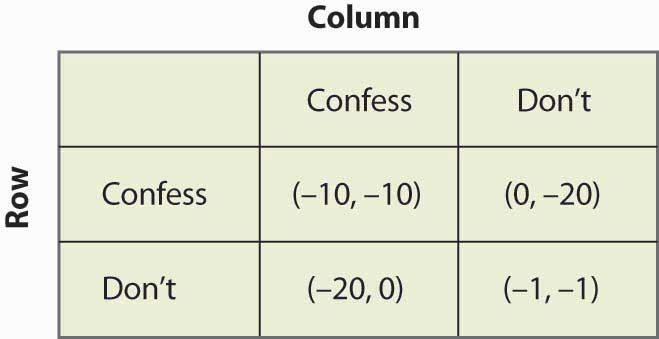
In the prisoner's dilemma, two criminals named Row and Column accept been apprehended by the police and are being questioned separately. They are jointly guilty of the crime. Each player can choose either to confess or not. If Row confesses, we are in the summit row of the matrix (respective to the row labeled "Confess"). Similarly, if Column confesses, the payoff will be in the relevant column. In this example, if only one histrion confesses, that player goes free and the other serves xx years in jail. (The entries correspond to the number of years lost to prison. The first entry is e'er Row's payoff; the second entry is Column'due south payoff.) Thus, for case, if Column confesses and Row does not, the relevant payoff is the get-go column and the second row.
Figure sixteen.two Solving the prisoner'due south dilemma
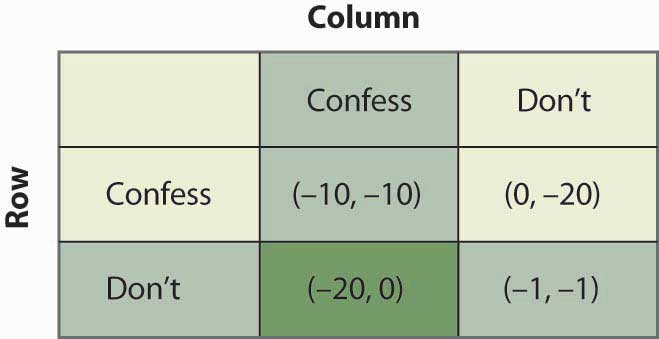
If Column confesses and Row does not, Row loses twenty years, and Cavalcade loses no years; that is, it goes free. This is the payoff (–20, 0) in reverse colour in Figure 16.2 "Solving the prisoner's dilemma". If both confess, they are both bedevilled and neither goes free, but they only serve 10 years each. Finally, if neither confesses, in that location is a 10% run a risk that they are convicted anyway (using evidence other than the confession), in which case they each average a year lost.
The prisoner's dilemma is famous partly considering it is readily solvable. First, Row has a strict advantage to confessing, no matter what Column is going to do. If Column confesses, Row gets –10 for confessing, –xx for not confessing, and thus is better off confessing. Similarly, if Cavalcade doesn't confess, Row gets 0 for confessing (namely, goes costless), –1 for not confessing, and is better off confessing. Either manner, no thing what Column does, Row should cull to confess.If Row and Column are friends and care about each other, that should exist included every bit part of the payoffs. Here, there is no honor or friendship among thieves, and Row and Column merely care about what they themselves will get. This is called a dominant strategyA strategy that is optimal no matter what the other players do. , a strategy that is optimal no matter what the other players do.
The logic is exactly similar for Column: No matter what Row does, Column should choose to confess. That is, Column also has a ascendant strategy to confess. To establish this, first consider what Cavalcade's all-time action is, when Cavalcade thinks Row will confess. Then consider Cavalcade's best action when Column thinks Row won't confess. Either way, Column gets a higher payoff (lower number of years lost to prison house) by confessing.
The presence of a ascendant strategy makes the prisoner's dilemma particularly easy to solve. Both players should confess. Note that this gets them 10 years each in prison, and thus isn't a very good outcome from their perspective; but there is nothing they tin can practise about it in the context of the game, because for each the alternative to serving 10 years is to serve 20 years. This issue is referred to as (Confess, Confess), where the first entry is the row player'due south choice, and the second entry is the column player'due south choice.
Figure 16.iii An entry game
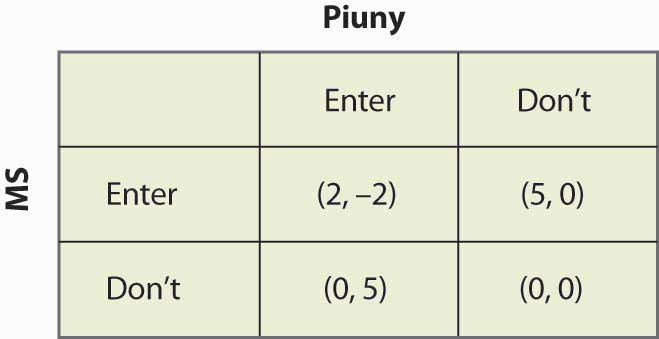
Consider an entry game played by Microsoft (the row role player) and Piuny (the column player), a minor beginning-up company. Both Microsoft and Piuny are thinking nigh entering a new market for an online service. Effigy 16.3 "An entry game" provides the payoff structure.
In this case, if both companies enter, Microsoft ultimately wins the market, earning 2 and Piuny loses 2. If either house has the market place to itself, it gets v and the other firm gets zero. If neither enters, they both go zilch. Microsoft has a dominant strategy to enter: It gets ii when Piuny enters, 5 when Piuny doesn't, and in both cases it does improve than when information technology doesn't enter. In contrast, Piuny does not have a dominant strategy: Piuny wants to enter when Microsoft doesn't, and vice versa. That is, Piuny's optimal strategy depends upon Microsoft's action; or, more than accurately, Piuny's optimal strategy depends upon what Piuny believes Microsoft volition do.
Piuny can empathize Microsoft'due south dominant strategy if information technology knows the payoffs of Microsoft.Information technology isn't and so obvious that one player will know the payoffs of another player, which often causes players to try to signal that they are going to play a certain manner—that is, to demonstrate commitment to a item advantageous strategy. Such topics are taken upward in business strategy and managerial economics. Thus, Piuny tin conclude that Microsoft is going to enter, and this means that Piuny should non enter. Thus, the equilibrium of the game is for Microsoft to enter and Piuny not to enter. This equilibrium is arrived at past the iterated elimination of dominated strategiesEliminating strategies by sequentially removing strategies that are dominated for a role player. , eliminating strategies past sequentially removing strategies that are dominated for a player. First, we eliminated Microsoft's dominated strategy in favor of its ascendant strategy. Microsoft had a dominant strategy to enter, which ways that the strategy of not entering was dominated past the strategy of entering, so we eliminated the dominated strategy. That leaves a simplified game in which Microsoft enters, every bit shown in Figure 16.iv "Eliminating a dominated strategy".
Figure 16.4 Eliminating a dominated strategy
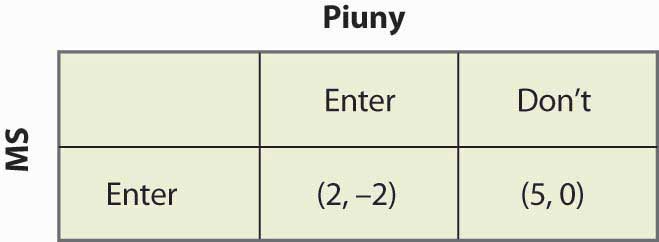
In this simplified game, subsequently the elimination of Microsoft'south dominated strategy, Piuny likewise has a dominant strategy: non to enter. Thus, we iterate and eliminate dominated strategies again—this fourth dimension eliminating Piuny's dominated strategies—and current of air upwardly with a single outcome: Microsoft enters, and Piuny doesn't. The iterated elimination of dominated strategies solves the game.A strategy may be dominated non by any particular alternate strategy but by a randomization over other strategies, which is an advanced topic not considered here.
Figure 16.v "A iii x 3 game" shows another game, with 3 strategies for each player.
Figure 16.v A 3 x three game
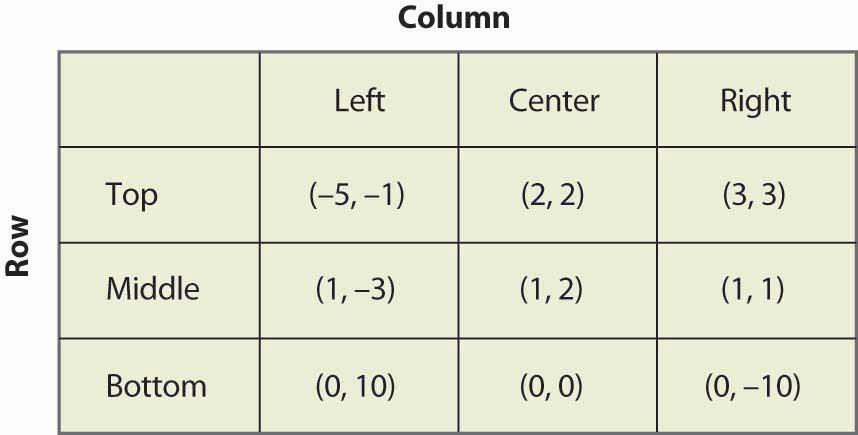
The process of iterated elimination of dominated strategies is illustrated in Figure 16.6 "Eliminating a dominated strategy" by actually eliminating the rows and columns, as follows. A reverse colour (white text on black groundwork) indicates a dominated strategy.
Middle dominates Bottom for Row, yielding:
Figure 16.6 Eliminating a dominated strategy
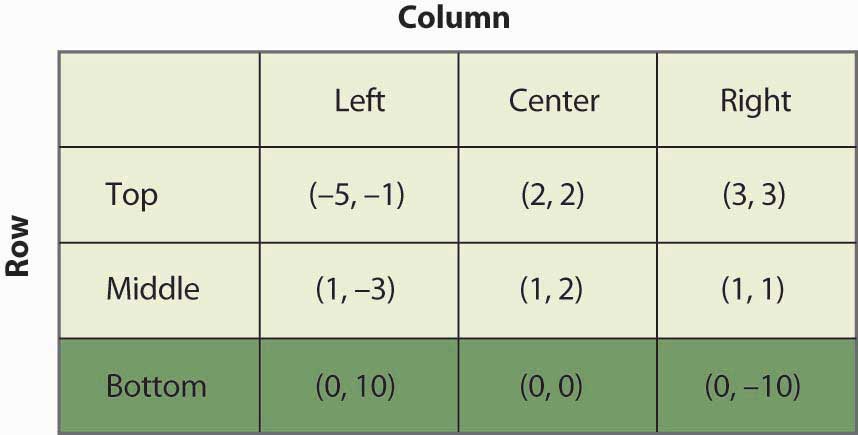
With Bottom eliminated, Left is now dominated for Column past either Center or Right, which eliminates the Left Column. This is shown in Effigy 16.7 "Eliminating some other dominated strategy".
Figure 16.seven Eliminating some other dominated strategy
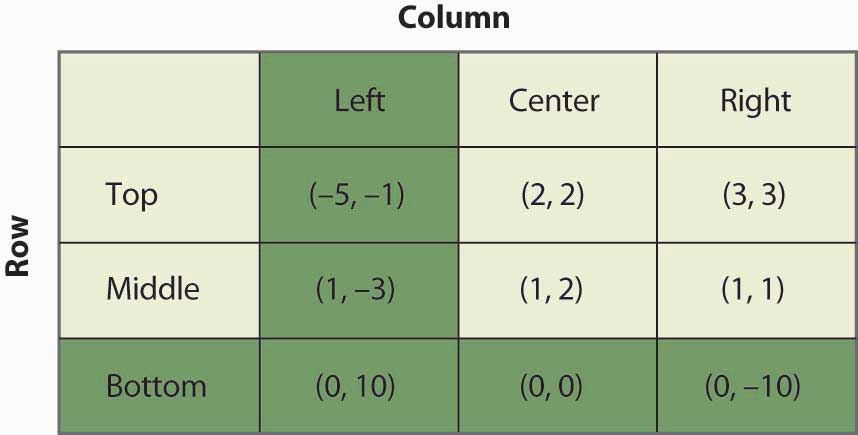
With Left and Bottom eliminated, Top now dominates Middle for Row, as shown in Figure xvi.8 "Eliminating a tertiary dominated strategy".
Figure sixteen.viii Eliminating a tertiary dominated strategy
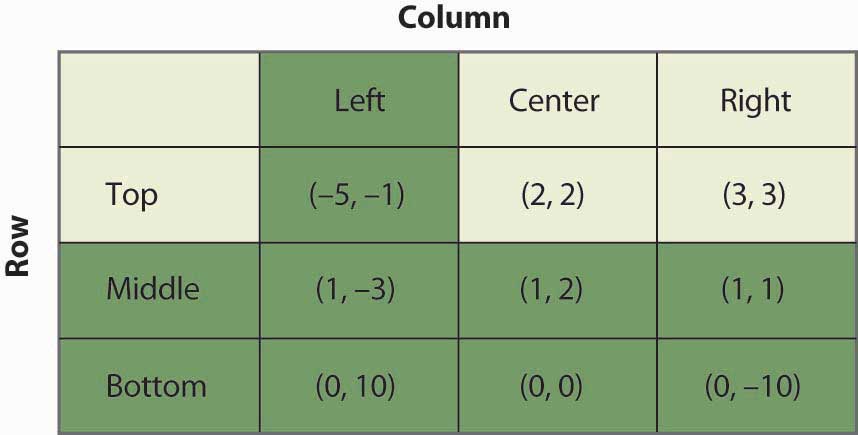
Finally, as shown in Figure sixteen.nine "Game solved", Column chooses Correct over Eye, yielding a unique outcome after the iterated elimination of dominated strategies, which is (Meridian, Right).
Figure 16.9 Game solved
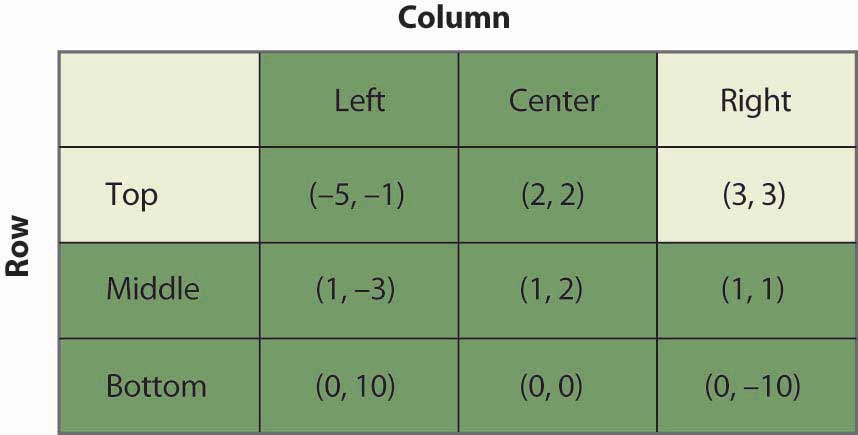
The iterated elimination of dominated strategies is a useful concept, and when it applies, the predicted event is usually quite reasonable. Certainly it has the holding that no thespian has an incentive to change his or her behavior given the behavior of others. Still, there are games where it doesn't employ, and these games crave the machinery of a Nash equilibrium, named for Nobel laureate John Nash (1928–).
Key Takeaways
- Strategic behavior arises where there are few enough market participants that their actions individually matter, and where the behavior of whatsoever ane participant influences choices of the other participants.
- Game theory is the study of how people play games. A game consists of the players, their data and available deportment, and payoffs.
- In a matrix payoff game, all deportment are chosen simultaneously. The row player chooses a row in a matrix; the column role player simultaneously chooses a column. The issue of the game is a pair of payoffs where the first entry is the payoff of the row histrion, and the second is the payoff of the cavalcade histrion.
- In the prisoner's dilemma, two criminals named Row and Column accept been apprehended by the police force and are being questioned separately. They are jointly guilty of the crime. Each player can choose either to confess or non. Each thespian individually benefits from confessing, but together they are harmed.
- A dominant strategy is a strategy that is best for a role player no matter what others choose.
- Iterated elimination of dominated strategies first removes strategies dominated by others, then checks if any new strategies are dominated and removes them, and and then on. In many cases, iterated emptying of dominated strategies solves a game.
Source: https://saylordotorg.github.io/text_introduction-to-economic-analysis/s17-01-matrix-games.html
0 Response to "refer to game matrix i. what are the dominant strategies in this game?"
Post a Comment